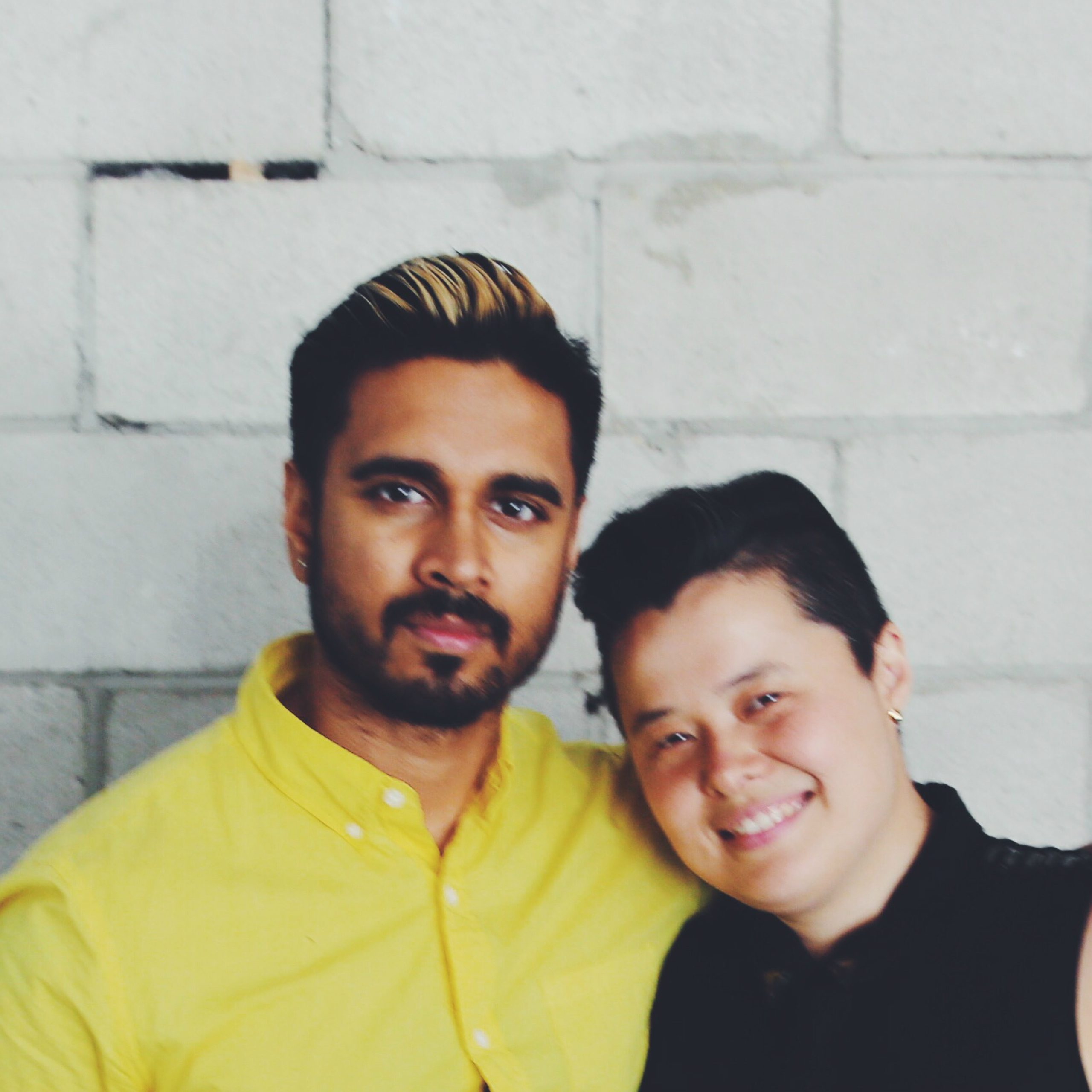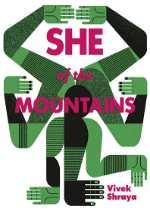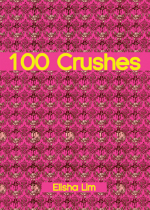Writers Vivek Shraya and Elisha Lim Talk Craft, Race, Identity, and Getting Compensated for Your Work

Author: Theodore Kerr
March 21, 2015
Late last year, Elisha Lim and Vivek Shraya embarked on a nine-city book tour, traveling from Boston to St. Louis and stops in between, promoting their recent new releases. Lim’s 100 Crushes (Koyama Press), a 2015 LGBT Graphic Novel Lambda Literary Award finalist, is a graphic novel anthology bringing together Lim’s work from 2008 to the present and exploring community, race, crushes, identity and more. Shraya’s novel, She of the Mountains (Arsenal Pulp Press), a 2015 Bisexual Fiction Lambda Literary Award finalist, is a contemporary bisexual love story intertwined with Hindu mythology.
One of the two readings during the New York stop of the tour was at Barnard College and was co-hosted by the school’s Library and Academic Information Services and the Asian American Writers’ Workshop. Introducing the evening, librarian Vani Natarajan said, “Vivek and Elisha’s new books make me want to do the impossible: go back in time so that they could have been a part of my life when I was a much younger queer South Asian girl dizzily searching the library stacks to find books that could tell me more, in images and words, about being queer and brown, histories of migration, myths passed down from generation to generation and communities: ones that are already so close to us, ones we wish for.”
As part of the evening, Lim showed They, a short film inspired by one of the stories from 100 Crushes and then shared a slide show of images and text from the book, interjecting touching and funny stories. With illustrations from the book behind him, Shraya performed passages from She of The Mountains, including singing pop and traditional Hindu songs. The audience was enraptured, making for a personal question-and-answer period. Topics covered ranged from religion and sexuality, to funding and the importance of finding worth in your own work as an artist who is also a queer person of color.
Below is text from the Q&A period, edited for publication by Lim, Shraya, writer Theodore Kerr and Jyothi Natarajan, the Managing Editor of The Asian American Writers’ Workshop.
What is the thing that you wanted to make that you have not had time to make yet?
ELISHA LIM: Someone once asked me: What would you make if you didn’t care about being fashionable? As an answer, I started making “Queers Who Pray,” which I played a bit of here tonight. It is a project I love that I have not had time to work on. It involves seven queers of color from different faith backgrounds praying. No preamble, no explanations, just the raw stuff. Recently, I’ve had an enormous drawing block, and I can’t finish it for the life of me.
VIVEK SHRAYA: I have always wanted to be a dancer. In Edmonton, the city I grew up in, there was a teacher that taught an Indian style of dance called Bharatanatyam. The teacher approached my parents because she believed I had potential, but they said no because they were worried about dance being only for girls. My hope is to explore dance and even Bharatanatyam specifically in future works.
Can you both tell us more about your books?
VS: I wanted to create a project that would challenge the biphobia I have encountered as a queer/bi person. I thought the best way to do that was to write a love story, and one that hopefully readers would fall in love with and also be challenged by. But I found that I couldn’t write about love without writing about hate—how the experience of hate embeds itself within the body and prevents the experience of love. In thinking about bodies, I started recalling stories in Hindu mythology I grew up hearing, in which Hindu gods would be born out of each other’s nostrils, navels and sweat. Reimagining these narratives of embodiment in Hindu mythology gradually became a counterpoint to the protagonist’s relationship to his body in the book. The book is illustrated by the amazing Raymond Biesinger, who is also originally from Edmonton, which made the process of collaborating together extra-special.
EL: I created 100 Crushes because I’m really excited about my community. I wanted to tell the world about this magical group of people who have changed my life: queer and trans people of color. I draw and write about sissies, dandies, butches and trans folks, all of them people of color. I decorate them all through my eyes. I think they’re incredible, like mystical inventors and triumphant phoenixes. They survive, thrive and celebrate difference with the most resourceful, ingenious plumage. I try to capture this in pen, paint and vibrant digital color. As I say in my biography, I celebrate the power of being neither straight, nor white, nor cis-gendered, and this book is my hymn.
Did being raised in religious contexts with so many personas (Catholic saints, Hindu deities) inform the way your stories deal with superhuman quality in the sense of their queerness being “beyond” human traits?
EL: I think I can see the Catholic narrative interfering with the way that I tend to tell stories. I think I see it in the way I build all of my stories around a climax: man has fallen, and is saved by Jesus’ resurrection. I have a cheap habit of writing a sentimental queer ending, which I am trying to do less of these days. I am trying to tell sadder stories. For example, my zine “Favorite Dating Tales” has no happy ending, and I’m pleased; I think it works beautifully. It’s a story about my dating life, which relates to my stories of guilt and contrition, and that relates to Catholicism, religion and why I can’t date. My fears resurrected—voilà!
VS: For me, the link between queerness and Hindu mythology goes back to growing up in the ‘80s and ‘90s without queer role models. This resulted in me turning Hindu gods into my first queer role models, especially in relation to gender. Hindu male gods often have long hair and wear jewelry. Lord Krishna, in particular, was surrounded by women, and he liked to sing and dance. Naturally, I was drawn to Hindu spaces, because there, these traits that I too embodied were celebrated, unlike North American settings where these traits elicited genderphobia.
Can you speak about funding? There seems to be a difference between how it works in Canada and in the U.S.
VS: Firstly, I just want to say that it’s hard to talk about money publicly, especially as an artist. We are not supposed to be “in it” for the money, but rather for the love. And of course, I love making art. But art is also labor, and if it’s consumed and enjoyed, shouldn’t there be some compensation? Yet, even saying that feels wrong because I think culturally, we are repeatedly taught not to value art or rather that appreciating art is value; it is compensation in and of itself. And this is only partially true. And I say this as an artist of color whose art production for over a decade has been largely self-funded.
I have had very little success with grant funding in Canada. The most I ever received was a travel grant for $1000, which of course I am grateful for. But there does seem to be a science or magic to grants, because the people who receive them seem to be consistently successful in receiving them. Consequently, I have worked a full-time job since I started my career as an artist in order to fund my own work. The dream was always that one day, the art would take off and pay for itself. But now, I am in a place where there is interest in my work, but I am still having to work my day job because the art doesn’t really pay. It’s literally like I work two full-time jobs. I have been doing this for twelve years, and it requires a lot of discipline. I work my 9 to 5, come home, have dinner, then turn on the computer and work again, when really, all I want to do is watch TV and cuddle with a bag of chips.
EL: I know what you’re asking. Unlike in the States, in Canada, we do have art funding from arts councils. We have grants from various levels of government. And our artist-of-color predecessors have fought hard to make sure that the juries for those grants are made up of a diverse group of people.
VS: My experience with touring with and booking U.S. artists is that post-secondaries in the US have significantly more funding. But I could be wrong!
What is the art process like for you?
EL: The fun part lasts for about two days. I fall in love with an idea, I can’t think about anything else…and then, the work of it sets in: the endless tedious days of getting it done, in time for a deadline or proposal. I start to behave like a terrible unfaithful lover. Was this a good idea? Should I start another idea instead? Oh, I just had another idea, and I’d rather be doing that right now. But seriously, the heart of the process for me is about social justice and anti-racism. And in these terms, it is so depressing. I want to be part of great change, but I talk to curators and art professionals about racism and segregation in the art world, and they look at me like I’m uneducated and ‘don’t get art.’ So I’m going to start an MFA next year so I can fight on a level playing field. Wish me luck!
 But let me spread the word about great Toronto artists who are leading social change: Andrea Fatona, who started the art conference The State Of Blackness; Zanette Singh, who confounded the Cue grant for marginalized artists; Sandra Brewster, who works with homeless artists; The Nia Centre for Black artists; Deanna Bowen, who is changing university policies; my boss, Gaetane Verna, one of the only Black women to direct a Canadian art gallery; Syrus Ware, who programs artists of color into our biggest gallery, the AGO; radical artists like Bonnie Devine, Kent Monkman, Richard Fung and my ingenious partner, Raven Davis. Look them up! And don’t stop making work!
But let me spread the word about great Toronto artists who are leading social change: Andrea Fatona, who started the art conference The State Of Blackness; Zanette Singh, who confounded the Cue grant for marginalized artists; Sandra Brewster, who works with homeless artists; The Nia Centre for Black artists; Deanna Bowen, who is changing university policies; my boss, Gaetane Verna, one of the only Black women to direct a Canadian art gallery; Syrus Ware, who programs artists of color into our biggest gallery, the AGO; radical artists like Bonnie Devine, Kent Monkman, Richard Fung and my ingenious partner, Raven Davis. Look them up! And don’t stop making work!
VS: The writing process for me often involves never-ending negative internal dialogue, like “You suck, no one is going to read this, why are you even doing this?” and after fifteen minutes of this, my creative energy is spent, and I’m like, ”OK, nap time.” The more I produce, the more I write, the harder it gets! The way I manage that is to just write a lot. There are a lot of standard writing tips—i.e. try writing in the morning, try writing at night, try writing on public transportation—and some people find one tip that works for them. I find the way to jog my mind, or interrupt where my mind wants to go, is by trying everything. Sometimes, this means converting all the text to Times New Roman (eww).
Thinking about the community of comic artists like Michael Deforge and Annie Koyama and her whole publishing empire, it feels like a lot of good stuff is happening in Toronto right now. What is going on?
EL: I love Michael DeForge! I am so proud to share his label; he is a raging genius. So much good is happening in Toronto, and it’s happening at the independent level, like Koyama Press, TCAF, Ill Nana, Freedom School, Lost Lyrics, State of Blackness, Blockorama and Yamantaka Sonic Titan. I think it’s because we’re the most racially diverse city in the world. Bam!
 VS: I have a very complicated relationship with Toronto. My anxiety level is always at fifteen out of ten there. There is a frantic energy and insecurity, which has made it difficult to create and sustain relationships. But I also feel bound to the city, especially because it’s one of the few places in the world that I can take the public transit and not be the only person of color, or queer person, or queer person of color. Toronto’s diversity, for the lack of a better word, is truly unique.
VS: I have a very complicated relationship with Toronto. My anxiety level is always at fifteen out of ten there. There is a frantic energy and insecurity, which has made it difficult to create and sustain relationships. But I also feel bound to the city, especially because it’s one of the few places in the world that I can take the public transit and not be the only person of color, or queer person, or queer person of color. Toronto’s diversity, for the lack of a better word, is truly unique.
How do come up with ideas for projects and complete them?
EL: My secret is that I lie. I will write to film festival programmers and curators and say, “I have this thing that would be perfect for you.” I won’t even have it done, but one out of ten may accept it, and then, that motivates me to finish it. It is a way to push myself. You can do it!
VS: I find a good idea painful until it is realized. This will sound narcissistic, but I get very paranoid, worrying that I will get hit by a car and the story I needed to tell or the art I needed to make will die with me. One of the results of homophobia in my teenage years was that I have a lot of suicidal ideation, which is unfortunate, but ironically, this has given me a sense of purpose in my life. I never thought I would make it past sixteen years old. I don’t treat life like it is going to keep going. I treat life with a sense of urgency, and I think this urgency has been ultimately useful to my artistic practice.
Seeing the General Idea retrospective at the Art Gallery of Ontario was also a turning point in relation to completing work. It was the first time that I was introduced to the concept of a body of work. I am a perfectionist, which can be hard because I obsess over every detail and want everything I make to be great. But if you think of your work as being part of a body, that is constantly growing and constantly evolving, then the impetus for perfection is minimized.
How do you deal with value in relation to your work? How do you value it in a world that might not?
EL: I was living in England, and I phoned my sister, who was living in Toronto. She told me that she’d joined a writing group called Asian Arts Freedom School, for writers of color. And I was like, how did you get in? And she was like, “I am a person of color, Elisha.” It was this shattering phone call. It wasn’t something I’d ever contended with before. After that, she sent me this book called Unpacking Your White Privilege that ruined my Christmas. So then, when I came back to Toronto and there was this incredible collaboration of amazing queer people of color artists communities and the Freedom School, it helped me feel entitled to take up space. It raised the stakes. I put out this calendar called “The Illustrated Gentleman,” of me following my butch and trans friends into change rooms. They’d tell me about their experiences and decisions in men’s stores. The images and text were online, and they got reblogged. But the only picture that kept on getting posted and reblogged was the single white person out of twelve queers. So the next year, I put together another calendar called “Sissy,” and it does not include one single white person. So when someone reblogs the project, they have to reblog us. My community makes me value my non-white identity and makes me feel that I have the right to exclusively dedicate my work to people of color.
VS: This is something that I struggle with a lot, especially as someone who is self-taught and comes into the arts through a DIY framework. My first two books were independently funded and my experience was often that because they weren’t published (by a publisher), they weren’t legitimate literary works. I experience this in the music industry as well, as an unsigned musician. Given this consistent experience, it’s hard at times for me not to turn against my art or myself, to not see myself as a real artist. That said, as a queer person of color, the greatest validation comes from other queer people of color who have made a connection to the art—like what Vani said earlier about how if she could go back to the past and introduce our work to her childhood self. Connections like that mean everything to me.

